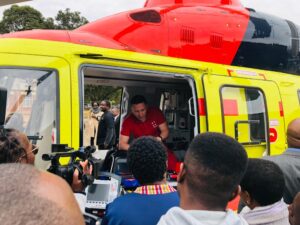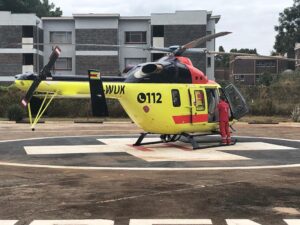Jeffrey Moyo
Government on Tuesday displayed its newly acquired air ambulances from Russia to doctors and nurses at Parirenyatwa and Sally Mugabe hospitals, the biggest hospitals in the country.
This follows a recent outcry that the helicopters were already being abused when it emerged that they were used as VIP transport at a recent ruling Zanu PF function.
Zimbabwe’s Health ministry recently received an allocation of 12 helicopters which authorities said would be used as air ambulances to ferry patients from across the country.

“We have received 12 helicopters from the government that shall be distributed at all points across the country so that people in areas where road ambulances can’t reach may be accessed with helicopter help,” Maxwell Mareza Hove, the acting permanent secretary in the Health ministry, told NewsHub.
Heads of departments at the Parirenyatwa Group of Hospital in Harare—Zimbabwe’s largest referral centre–took turns to explain to journalists how the helicopters worth millions of American dollars would help ease the hardships faced by patients countrywide.
The Zimbabwean government recently acquired 32 Kazan Ansat helicopters from Russia at a controversial cost of US$320 million.
Eighteen have been delivered to date and, according to the government, they are destined for law enforcement, tourism, disaster management and the health sector.

The engines are supplied by Pratt & Whitney, a Canadian entity whose parent company is Raytheon Technologies that is based in the USA.
Because of sanctions on Russia over the war in Ukraine, there are fears that Pratt & Whitney may have discontinued supplying the engines to Russian State Corporation (Rostec) that supplies the helicopters.
Critics have insisted that the purchase was misplaced since the cash-strapped country is suffering a severe shortage of road ambulances, drugs and medical equipment.
They also expressed the fear that the ambulances would soon be grounded due to a shortage of spare parts and expertise.
It was not immediately clear if the ambulances would operate for free, but Maximillan Dzowa, who heads surgery department at Parirenyatwa, said relevant authorities would decide in due course.
He hinted that the air ferry services would be subsidised.
“Even if people would be made to pay for using the air ambulances, it won’t be expensive because government is there to help its people considering that many people obviously are poor. However, all this shall be clarified as time progresses,” Dzowa told NewsHub.
Meanwhile, former health minister, Henry Madzorera, described the procurement of the air ambulances as unnecessary since the country does not have adequate road ambulances.
“It’s not a problem having air ambulances, but we still have areas that are not reachable by ordinary road ambulances, where many women still die while giving birth. Let’s first feed these remote areas with road ambulances that are affordable,” Madzorera told NewsHub.
However, Tapiwa Nyakudya, an accidents and emergencies expert, differed with the Madzorera.
“The ambulances would help quite a lot to transport patients with speed from any point in the country, especially those that would be seriously sick, or the critically injured.
“There is what we call the golden hour which in medical terms refers to the extent of sickness or injury which when attended by doctors on time, one can be assisted and survive and for this, air ambulances come in handy,” said Nyakudya, a medical doctor.


Comments are closed.